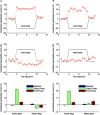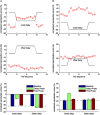Duration reproduction with sensory feedback delay: differential involvement of perception and action time
- PMID: 23087628
- PMCID: PMC3472406
- DOI: 10.3389/fnint.2012.00095
Duration reproduction with sensory feedback delay: differential involvement of perception and action time
Abstract
Previous research has shown that voluntary action can attract subsequent, delayed feedback events toward the action, and adaptation to the sensorimotor delay can even reverse motor-sensory temporal order judgments. However, whether and how sensorimotor delay affects duration reproduction is still unclear. To investigate this, we injected an onset- or offset-delay to the sensory feedback signal from a duration reproduction task. We compared duration reproductions within (visual, auditory) modality and across audiovisual modalities with feedback signal onset- and offset-delay manipulations. We found that the reproduced duration was lengthened in both visual and auditory feedback signal onset-delay conditions. The lengthening effect was evident immediately, on the first trial with the onset-delay. However, when the onset of the feedback signal was prior to the action, the lengthening effect was diminished. In contrast, a shortening effect was found with feedback signal offset-delay, though the effect was weaker and manifested only in the auditory offset-delay condition. These findings indicate that participants tend to mix the onset of action and the feedback signal more when the feedback is delayed, and they heavily rely on motor-stop signals for the duration reproduction. Furthermore, auditory duration was overestimated compared to visual duration in crossmodal feedback conditions, and the overestimation of auditory duration (or the underestimation of visual duration) was independent of the delay manipulation.
Keywords: action; audition; time perception; time reproduction; vision.
Figures





Similar articles
-
Different contributions of efferent and reafferent feedback to sensorimotor temporal recalibration.Sci Rep. 2021 Nov 19;11(1):22631. doi: 10.1038/s41598-021-02016-5. Sci Rep. 2021. PMID: 34799622 Free PMC article.
-
The Build-Up and Transfer of Sensorimotor Temporal Recalibration Measured via a Synchronization Task.Front Psychol. 2012 Jul 12;3:246. doi: 10.3389/fpsyg.2012.00246. eCollection 2012. Front Psychol. 2012. PMID: 22807921 Free PMC article.
-
The absence or temporal offset of visual feedback does not influence adaptation to novel movement dynamics.J Neurophysiol. 2017 Oct 1;118(4):2483-2498. doi: 10.1152/jn.00636.2016. Epub 2017 Aug 9. J Neurophysiol. 2017. PMID: 28794198 Free PMC article.
-
Reducing bias in auditory duration reproduction by integrating the reproduced signal.PLoS One. 2013 Apr 16;8(4):e62065. doi: 10.1371/journal.pone.0062065. Print 2013. PLoS One. 2013. PMID: 23614014 Free PMC article.
-
Exposure to Auditory Feedback Delay while Speaking Induces Perceptual Habituation but does not Mitigate the Disruptive Effect of Delay on Speech Auditory-motor Learning.Neuroscience. 2020 Oct 15;446:213-224. doi: 10.1016/j.neuroscience.2020.07.041. Epub 2020 Jul 30. Neuroscience. 2020. PMID: 32738430 Free PMC article.
Cited by
-
Auditory Rate Perception Displays a Positive Serial Dependence.Iperception. 2020 Dec 22;11(6):2041669520982311. doi: 10.1177/2041669520982311. eCollection 2020 Nov-Dec. Iperception. 2020. PMID: 33425315 Free PMC article.
-
Logarithmic encoding of ensemble time intervals.Sci Rep. 2020 Oct 23;10(1):18174. doi: 10.1038/s41598-020-75191-6. Sci Rep. 2020. PMID: 33097781 Free PMC article.
-
The implicit sense of agency is not a perceptual effect but is a judgment effect.Cogn Process. 2022 Feb;23(1):1-13. doi: 10.1007/s10339-021-01066-x. Epub 2021 Nov 9. Cogn Process. 2022. PMID: 34751857 Review.
-
Predictive coding of multisensory timing.Curr Opin Behav Sci. 2016 Apr;8:200-206. doi: 10.1016/j.cobeha.2016.02.014. Epub 2016 Feb 17. Curr Opin Behav Sci. 2016. PMID: 27695705 Free PMC article.
-
Auditory Feedback Assists Post hoc Error Correction of Temporal Reproduction, and Perception of Self-Produced Time Intervals in Subsecond Range.Front Psychol. 2018 Jan 19;8:2325. doi: 10.3389/fpsyg.2017.02325. eCollection 2017. Front Psychol. 2018. PMID: 29403407 Free PMC article.
References
-
- Angrilli A., Cherubini P., Pavese A., Manfredini S. (1997). The influence of affective factors on time perception. Percept. Psychophy. 59, 972–982 - PubMed
-
- Brainard D. H. (1997). The psychophysics toolbox. Spat. Vis. 10, 433–436 - PubMed
-
- Bueti D., Walsh V. (2010). Memory for time distinguishes between perception and action. Perception 39, 81–90 - PubMed
LinkOut - more resources
Full Text Sources

